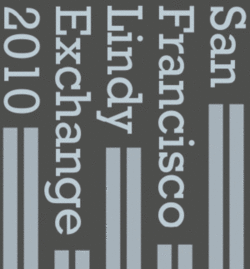

September 16-19th, 2010
SFLX Music Policy
We will have a diverse selection of music at SFLX 2010. After reviewing notes and survey responses from prior events, we have come up with a list of music guidelines for the 2010 event.Definitions
(Many of the chosen examples are intentionally those that many would consider "overplayed" because it's likely most dancers have heard of them).- Lindy: Classic
- Generally pre-WWII music, often characterized by an even backbeat. Offers a consistent driving rhythm, and can include a variety of tempos. Examples: "Boogie Woogie I May Be Wrong" by Count Basie, and other recordings from Count Basie's Decca years, "Hey-Ba-Ba-Re-Bop" and "Flying Home" by Lionel Hampton, "Lindy Hopper's Delight" by Chick Webb, "Christopher Columbus" by Benny Goodman, "Oh! Lady Be Good" by Artie Shaw, "Drop Me Off In Harlem" by Duke Ellington.
- Lindy: Groove
- The style of music that made the SF Lindy scene famous. It is generally from the post-WWII era, and is characterized by both up and medium tempos that often include syncopations and significant tempo and rhythm changes within a single song (in contrast to classic swing, which is characterized by an even, metronomic backbeat). Examples: "Rockhouse" by Ray Charles, "Lavender Coffin" by Lionel Hampton, "Golden Earrings" by Ray Bryant, "The Vibrator" by "Brother" Jack McDuff, "For Dancers Only" by Junior Mance, "Smack Dab In The Middle" by Gene Harris & Jack McDuff, "Going To Chicago" by Ernestine Anderson, and "Hard Times" by Ray Charles and Houston Person
- Blues
- Classic and contemporary blues, as well as jazz and ballads that are popular in the blues scene. Examples: "Come On In My Kitchen" by Robert Johnson , "I Live The Life I Love" by Buddy Guy, "The Thrill Is Gone" by B.B. King, "Boom Boom" by John Lee Hooker, "Black and Tan Fantasy" by Lincoln Center Jazz Orchestra, "St. James Infirmary" by Lou Rawls, "Feeling Good" by Nina Simone and "Dr. Feelgood" by Kim Massie. For SFLX, "blues music" will not include hiphop, triphop, soul, pop or fusion.